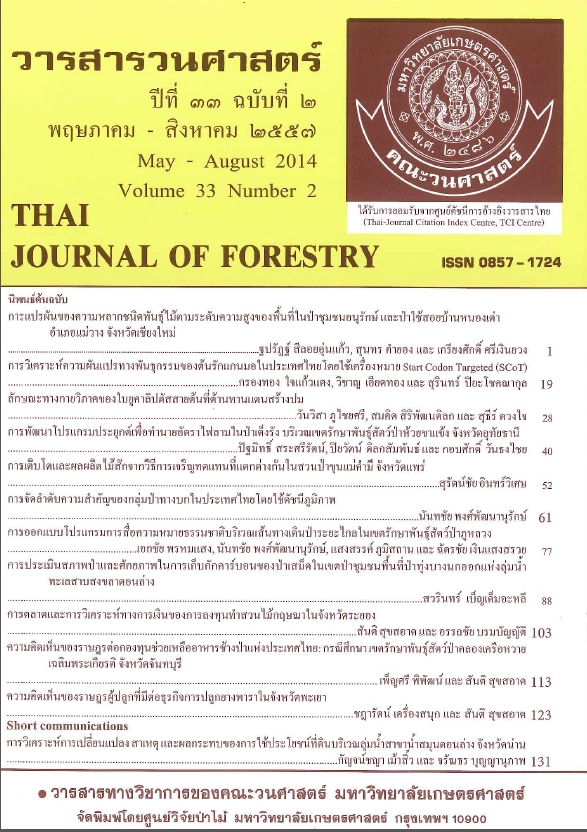การจัดลำดับความสำคัญของกลุ่มป่าทางบกในประเทศไทยโดยใช้ดัชนีภูมิภาพ
Main Article Content
บทคัดย่อ
การวางแผนการอนุรักษ์และการจัดการพื้นที่คุ้มครองในระดับภูมิภาคของประเทศไทยจำเป็นต้องมีความเข้าใจในเชิงลึกเกี่ยวกับโครงสร้างทางด้านภูมิภาพของพื้นที่ รวมถึงการได้รับการสนับสนุนข้อมูลเชิงพื้นที่อย่างเพียงพอเพื่อใช้เป็นเครื่องมือในการตัดสินใจให้แก่นักจัดการ การศึกษานี้มีจุดมุ่งหมายเพื่อการประเมินองค์ประกอบและรูปลักษณ์เชิงปริมาณของกลุ่มป่าทางบกจำนวน 17 แห่งของประเทศไทยโดยใช้ดัชนีภูมิภาพจำนวน 9 ตัวชี้วัด และนำผลที่ได้มาใช้ลำดับความสำคัญของกลุ่มป่าทางบก การประเมินโครงสร้างทางภูมิภาพได้กระทำบนพื้นฐานของสภาพสังคมพืชคลุมดินที่ได้มาจากแผนที่สภาพการใช้ที่ดินและป่าไม้ปี พ.ศ. 2543 การลำดับความสำคัญของกลุ่มป่าดำเนินการโดยการเปรียบเทียบค่าเฉลี่ยของดัชนีภูมิภาพทั้ง 9 ตัว จากการศึกษาพบว่ากลุ่มป่าที่มีความสำคัญในแง่การเป็นกลุ่มป่าที่สามารถรักษาความหลากหลายของประเภทสังคมพืชหรือระบบนิเวศป่าไม้จำแนกได้เป็น 4 ระดับ คือ กลุ่มป่าที่สำคัญยิ่ง ได้แก่กลุ่มป่าตะวันตก กลุ่มป่าที่มีความสำคัญมาก ได้แก่ กลุ่มป่าแม่ปิง-อมก๋อยกลุ่มป่าลำน้ำปาย-สาละวินกลุ่มป่าภูเมี่ยง-ภูทองกลุ่มป่าภูเขียว-น้ำหนาวกลุ่มป่าดงพญาเย็น-เขาใหญ่กลุ่มป่าดอยภูคา-แม่ยมกลุ่มป่าศรีลานนา-ขุนตาลและกลุ่มป่าแก่งกระจานกลุ่มป่าที่มีความสำคัญปานกลาง ได้แก่กลุ่มป่าตะวันออกกลุ่มป่าคลองแสง-เขาสกกลุ่มป่าภูพานและ กลุ่มป่าพนมดงรัก-ผาแต้มและกลุ่มป่าที่มีความสำคัญน้อย ได้แก่ กลุ่มป่าเขาหลวงกลุ่มป่าชุมพรกลุ่มป่าฮาลา-บาลาและกลุ่มป่าเขาบรรทัดจากผลการจัดลำดับความสำคัญของกลุ่มป่าตามโครงสร้างเชิงภูมิภาพของสภาพสังคมพืชคลุมดินทำให้เข้าใจถึงปัญหาและอุปสรรคต่อการอนุรักษ์ความหลากหลายทางชีวภาพ และสามารถช่วยในการจัดสรรงบประมาณและอัตรากำลังให้เกิดประสิทธิภาพมากขึ้นในอนาคต
คำสำคัญ: พื้นที่คุ้มครอง กลุ่มป่า การลำดับความสำคัญ ดัชนีภูมิภาพ
Downloads
Article Details

อนุญาตภายใต้เงื่อนไข Creative Commons Attribution-NonCommercial-NoDerivatives 4.0 International License.
ข้าพเจ้าและผู้เขียนร่วม (ถ้ามี) ขอรับรองว่า ต้นฉบับที่เสนอมานี้ยังไม่เคยได้รับการตีพิมพ์และไม่ได้อยู่ในระหว่างกระบวนการพิจารณาตีพิมพ์ลงในวารสารหรือสิ่งตีพิมพ์อื่นใด ข้าพเจ้าและผู้เขียนร่วม (ถ้ามี) ยอมรับหลักเกณฑ์และเงื่อนไขการพิจารณาต้นฉบับ ทั้งยินยอมให้กองบรรณาธิการมีสิทธิ์พิจารณาและตรวจแก้ต้นฉบับได้ตามที่เห็นสมควร พร้อมนี้ขอมอบลิขสิทธิ์ผลงานที่ได้รับการตีพิมพ์ให้แก่วารสารวนศาสตร์ คณะวนศาสตร์ มหาวิทยาลัยเกษตรศาสตร์ กรณีมีการฟ้องร้องเรื่องการละเมิดลิขสิทธิ์เกี่ยวกับภาพ กราฟ ข้อความส่วนใดส่วนหนึ่ง หรือ ข้อคิดเห็นที่ปรากฏในผลงาน ให้เป็นความรับผิดชอบของข้าพเจ้าและผู้เขียนร่วม (ถ้ามี) แต่เพียงฝ่ายเดียว และหากข้าพเจ้าและผู้เขียนร่วม (ถ้ามี) ประสงค์ถอนบทความในระหว่างกระบวนการพิจารณาของทางวารสาร ข้าพเจ้าและผู้เขียนร่วม (ถ้ามี) ยินดีรับผิดชอบค่าใช้จ่ายทั้งหมดที่เกิดขึ้นในกระบวนการพิจารณาบทความนั้น”


